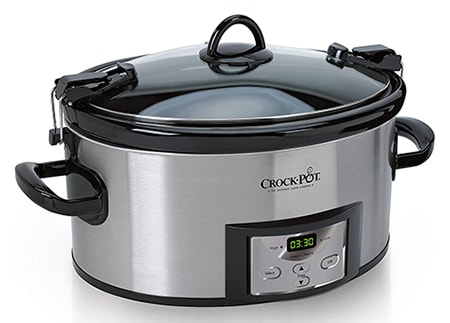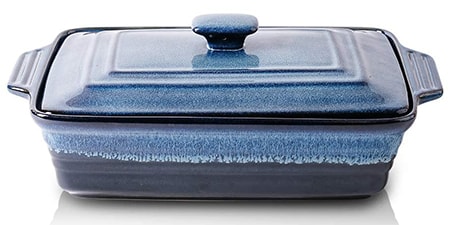13 Dutch Oven Substitutes: The Hottest Alternatives
Author: Anne Cowart | Editor: Omar Alonso
Review & Research: Jen Worst & Chris Miller

A dutch oven substitute can work just as well and even better in some instances, so don't worry if you don't have the genuine article in your kitchen at the moment. You likely have one of the alternatives within arm's reach right now.
Dutch ovens are truly multipurpose as they allow you to do many things—roast, sear, saute, boil, bake, fry, stew, slow, or fast cook. Made from heavy cast iron, their greatest advantage is the retention of heat that helps in cooking the food evenly.
This is because of its heavy lid, which prevents the steam from escaping and allows the condensation to drip back into the meal. The lid also tends to be spiked, enhancing this self basting action which keeps the meal moist and nutritious at high and low temperatures.
The Dutch oven is designed such that the flavors are absorbed during slow cooking and tougher cuts of meat can braise and become tender. Soft and juicy for the win!
They are a great asset in your kitchen if you have one. But if you don’t, don’t despair. There are suitable alternatives that can give you just as good a result as the Dutch oven substitute.
13 Dutch Oven Substitutes
We list below some of the other cooking vessels, comparing their performance, limitations and strengths with that of the Dutch oven.
Slow Cooker (for Near-Same Results)

A slow cooker is one of the best dutch oven alternatives because it follows the same cooking principles as the Dutch oven. In a way, you can say that the Dutch ovens are the original slow cookers.
One thing to remember, though, is that some are non-metallic cookware—ceramic or porcelain—but housed in a metal casing. These crock pots are dishwasher safe (the non-metal parts). Most of the current choices are metal, though. They run on electricity and operates on a lower heat than a Dutch oven, taking longer to cook.
Look for one that offers a pressure cooker function so that you can choose the recipe that suits your needs. It will enable you to use the same cook time as the Dutch oven by selecting the ‘high cook’ setting if you are in a hurry.
You can also keep it in the low setting for and double the cooking time depending on if you want to relish the process. The slow cooker is as versatile as the Dutch oven and lets you make braised or one-pot dishes, soups, and stews.
The slow cooker also lets you keep your food warm long after it has been cooked, just like the Dutch oven. Its only limitation is that you cannot brown the meat before simmering it in sauce. Use a cast-iron skillet for the purpose and then transfer it to the slow cook and finish the process.
Stockpot (the Next Best Thing)

If you have a stockpot with a heavy bottom and a tight lid, it can be an effective Dutch oven substitute. You can sauté and sear in low heat in this pot and then add the ingredients. The only caveat is that you must cook in low heat and check the liquid level regularly.
You can use the stockpot in the standard types of ovens by keeping the temperature between 250 and 275 degrees Fahrenheit for the best results. Preparation, checking the liquid levels regularly, and topping up if required is advisable.
The tall sides of the stockpot, which is also called the soup pot, are ideal for boiling pasta or simmering bone broth. Simmering soups and stews, making sauces and even braised meat dishes is possible. You cannot use it in the oven but cook it on the stovetop over a very low heat setting instead.
Instant Pot (the Wonder Dish)

The Instant Pot, the new kid on the block, has quickly taken over the imagination of passionate cooks and novices. It is a seven-in-one appliance that can handle most recipes, especially the ones that you make in the Dutch oven.
That too, in a fraction of the time. All you need to do is, add the ingredients to the pot, set the timer and relax till it is time to eat!
From cooking risotto to braised meats and stews get done faster by almost 30% faster because of the higher quantity of steam trapped inside the electric pressure cooker.
When you are using the Instant Pot, you can reduce the cooking time by a third of what you need in the Dutch oven. You can also use less water in this alternative to a Dutch oven.
Clay Pot (a Close Second)

The clay pot, like a Dutch oven, has a lid, a cone, that collects the rising steam which then condenses and slides back into the dish. This process is known as self-basting and keeps the dishes moist and nutritious.
Earlier, just like the Dutch oven, ceramic clay pots were not glazed and so could be placed directly on the source of heat. But now they come with an enamel coating so place a diffuser between the direct heat and the pot.
Braiser (Size Matters)

If you have a braiser then you can certainly use it as a Dutch oven substitute for most of the dishes with a minor tweak. The circumference and the height of the pots’ walls may be different, so adapt your recipe accordingly.
Typically, it is shallower than a Dutch oven and has sloping sides that contain liquid. It has a wide cooking surface that is good for browning and braising different kinds of foods. The shallowness can be a limitation depending on what you want to cook.
Metal Pot (with Some Tweaks)

Metal types of pots can be used, but read the instructions carefully to know the ideal way to use your recipe in that. Best is not to preheat your metal pot as metals such as stainless steel can heat up faster than a Dutch oven and not distribute heat evenly.
Since the bottom can also burn quickly, low heat is safest. Place a sheet pan on top of the metal pot when you keep it in an oven to protect the top.
Casserole Dish (a Fair Replacement)

For the casserole that can work similar to a Dutch oven, choose one that has depth with a tight-fitting lid. Typically, casseroles are made of materials that cannot be kept on a direct heat source.
Therefore, you will need a frying pan to saute or sear the ingredients before placing them inside the casserole. Otherwise it's a great substitute for a Dutch oven.
Ceramic Pot (Handle with Care)

You can use this pot like a Dutch oven and place it inside the oven too if required. They are easy to clean and non-stick. What's nice is you can serve right out of these if you have a nice enough one like when staging a dining room, you can set it right at the center of the table.
Not only are they scratch resistant but also affordable. However, handle them with care as they are brittle and cannot be used directly on the stovetop of any types of stoves.
French Oven (Enameled Iron)

The Dutch oven was designed in the 1700s for the Dutch in Pennsylvania. It is made of cast iron with a tight-fitting lid and is a heavy pot.
A French oven is a modern variation made from enamelled cast iron in France. In recent times, the enameled version has become more popular but both serve the same purpose. The two terms are used loosely and interchangeably.
Skillet (Limited Use)

The skillet has a strong and wide base, making it ideal for sauteing, searing, frying, and even roasting. But slow cooking or making stew will not be possible due to its shorter sides. It also does not usually come with a cover, but you'll need one to use it as a dutch oven.
Frying Pan (Mostly There)

Except baking, a frying pan just needs a lid to replace the Dutch oven. Add the other ingredients after sauteing and searing and let it simmer over low heat to cook your meals just the way you want. Of course you can use these types of pans in a ton of other ways, too. This is an essential to have around.
Roasting Pan (With Limitations)

A roasting pan does not come with a lid so there is no self-basting happening. It can be used for roasting meat, cooking vegetables, making gravies and baking.
The Dutch oven is a little more versatile, allowing you to cook even dishes such as stews, soups, desserts, oats, popcorns, beans and slow-cooked meals. Again, you just need a lid of some sort here.
Glass Casserole (Sometimes)

Glass is a poor conductor of heat but can retain heat evenly and for a longer time. What matters when you're using the glassware is the temperature, the cooking time, and the ingredients that go into it.
Glass cannot be kept directly on the source of heat and can shatter in high temperatures. The lids won't seal the mouth to prevent steam from escaping and so there is no self-basting happening. Slow cooking is difficult. It can be used in the microwave for cooking or reheating.
What Can I Use Instead of a Dutch Oven?
The Dutch oven is a versatile vessel that lets you cook many varieties of dishes. If you have one, you don’t need any other. If you decide to buy one you will also get different sizes, brands and prices to choose from.
But don't worry if you don't have one. Any of the 13 dutch oven alternatives above will get the job done, and some more effectively, like the Instant pot.
Dutch Oven Alternatives Make a Great Substitute
But if you don't own a Dutch oven and have any of the above, then you're still good to take care of your meal options. Just read the instructions that came with the cookware to see what its limitations are.
Make sure you know the temperature the cookware can handle, the duration of cooking, and its sturdiness. Sometimes two types of cookware may be needed to replace the Dutch oven.
But there are tweaks and workarounds available even in such a case so you should be able to manage well and whip up a great dish. Happy cooking with your Dutch oven substitute.
You'll Also Enjoy:
- 35 Different Types of Drinking Glasses & Their Uses
- Types of Coffee Makers: Choosing Correctly & Why It Matters
- How To Store Honey for Better Quality, Saving Money, & Helping Bees
- How to Make a Cutting Board: It's Not as Hard as You Think
- 28 Kitchen Sink Ideas to Impress While Best Utilizing Your Space




